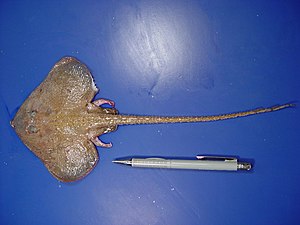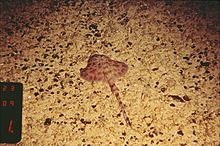Gurgesiellidae
| Gurgesiellidae | ||||||||||||
|---|---|---|---|---|---|---|---|---|---|---|---|---|

Fenestraja ishiyamai from the Gulf of Mexico |
||||||||||||
| Systematics | ||||||||||||
|
||||||||||||
| Scientific name | ||||||||||||
| Gurgesiellidae | ||||||||||||
| De Buen , 1959 |
The Gurgesiellidae are a family of the rays (Batoidea). It consists of three genera with almost 20 species that occur in the tropical and subtropical Atlantic, Pacific and Indian Oceans. In English they are called English Pygmy skates "Zwergrochen".
features
They are small to very small, 20 to 59 centimeters long stingrays with a rhombic or heart-shaped body disc and a hard, short or slightly elongated and pointed snout. The ends of the pectoral fins are pointed or rounded, the tail is firm, slender and long to very long. The pelvic fins of the Crurirajini tribe are split with a finger-like anterior lobe, with which they can walk across the seabed like legs. The pelvic fins of the Gurgesiellini tribe are undivided. The tail of the Crurirajini tribe has two small dorsal fins, the Gurgesiellini species have only one or no dorsal fin. A very small caudal fin is found at the tail end. The back of the Gurgesiellidae is covered with small thorns; the pattern of the thorns differs from species to species. The snout of the genus Cruriraja is also provided with thorns, in the genus Fenestraja it is thornless. In the genera Cruriraja and Fenestraja , the region around the eyes, the neck and the center line of the back and tail are also provided with thorns, in Gurgesiella these thorns are largely absent.
Way of life
The different species of the Gurgesiellidae occur on the continental shelf and the shelf around islands to a depth of 1100 meters. However, some species have also been caught near the coast at depths of 40 meters. Like most rays, they are bottom -dwelling and feed on invertebrates that live in the ocean floor and on small fish. They can move the finger-like front lobe of the pelvic fins like legs and thus run across the sea floor. The Gurgesiellidae are not viviparous.
Systematics
The Gurgesiellidae family was introduced in 1959 by the Spanish ichthyologist (ichthyologist) Fernando de Buen y Lozano together with the genus Gurgesiella , with Gurgesiella remaining the only genus in the family. Gurgesiella was later assigned to the real rays (Rajidae). Also cruriraja and Fenestraja originally belonged to the genuine rays. With the publication of the standard work Rays of the World , the family was revalidated again, as DNA comparisons have shown that the genera Cruriraja , Fenestraja and Gurgesiella have a different position in the family tree from the real rays. Since Cruriraja and Fenestraja on the one hand and Gurgesiella on the other hand differ greatly both morphologically and in their DNA, the Gurgesiellidae family was divided into two tribes.
Genera and species
- Crurirajini tribe
- Genus Cruriraja Bigelow & Schroeder, 1948
- Cruriraja andamanica (Lloyd, 1909)
- Cruriraja atlantis Bigelow & Schroeder, 1948
- Cruriraja cadenati Bigelow & Schroeder, 1962
- Cruriraja durbanensis (from Bonde & Swart, 1923)
- Cruriraja hulleyi Aschliman, Ebert & Compagno, 2010
- Cruriraja parcomaculata (from Bonde & Swart, 1923)
- Cruriraja poeyi Bigelow & Schroeder, 1948
- Cruriraja rugosa Bigelow & Schroeder, 1958
- Genus Fenestraja McEachran & Compagno, 1982
- Fenestraja atripinna (Bigelow & Schroeder, 1950)
- Fenestraja cubensis (Bigelow & Schroeder, 1950)
- Fenestraja ishiyamai (Bigelow & Schroeder, 1962)
- Fenestraja maceachrani (Séret, 1989)
- Fenestraja mamillidens (Alcock, 1889)
- Fenestraja plutonia (Garman, 1881)
- Fenestraja sibogae (Weber, 1913)
- Fenestraja sinusmexicanus (Bigelow & Schroeder, 1950)
- Genus Cruriraja Bigelow & Schroeder, 1948
- Gurgesiellini tribe
- Genus Gurgesiella de Buen, 1959
- Gurgesiella atlantica (Bigelow & Schroeder, 1962)
- Gurgesiella dorsalifera McEachran & Compagno, 1980
- Gurgesiella furvescens de Buen, 1959
- Genus Gurgesiella de Buen, 1959
Individual evidence
- ↑ a b F. de Buen: Notas preliminares sobre la fauna marina pre abismal de chile, con descripción de una familia de rayas, dos géneros y siete especies nuevos. In: Boletín del Museo Nacional de Historia Natural Chile , Volume 27, No. 3, pp. 173–201, 1959 (digitized version )
- ↑ a b c Weigmann, S., Séret, B., Last, PR & McEachran, JD 2016. Pygmy Skates, Family Gurgesiellidae. Pages 473-493 in Last, PR, White, WT, Carvalho, MR, Séret, B., Stehmann, M. & Naylor, GJP Rays of the World. CSIRO Publishing: Melbourne. ISBN 9780643109131 .
- ↑ Fenestraja cubensis on Fishbase.org (English)
- ↑ Cruriraja hulleyi on Fishbase.org (English)
- ^ Last, PR, Weigmann, S. & Yang, L. (2016): Changes to the nomenclature of the skates (Chondrichthyes: Rajiformes). Pages 11 to 34 in Last, PR & Yearsley, GK (Ed.) (2016): Rays of the World: Supplementary information. CSIRO Australian National Fish Collection.
